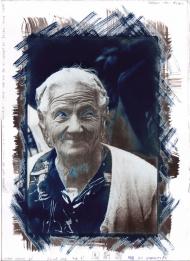Van Dyke Brown on cyanotype

A couple of years ago, while I was traveling by car in the south of Italy, I was talking with a friend from Naples, photographer himself, about alternative print techniques. In particular, I was talking about superimposing brown prints, or Van Dyke brown, to cyanotype prints.
The answer was quick and laconic:
- Blue and brown is not allowed! (NT: in Italian the rhyme goes with a word that means rude, boor)
There’s also the twin proverb to complete the opera: “black and brown never allowed”.
In reality, superimposing iron salts brown print on cyanotype is a technique, as every technique, that could be interesting, mostly when printing the hardest negatives or to recover bad VDB prints. This phrase could be rude, but actually in alternative techniques world it is better to let yourself go, letting destiny play its trickeries, leaving space to serendipity and accepting what fate will give to you. Those who work with this kind of prints are used to it to discover an alternative look, produce different images to the ones we’re used to, create unique prints. This is the reason why there’s nothing better than case or, if we want, chaos.
This is the reason why, in general, I suggest the apprentices of alternative techniques not to throw away anything, not even the worst print; it could become an interesting element to (re-) work on. New techniques, combinations and possibilities are discovered every day and that bad platinum once thrown away could be the perfect one to test the new learned technique.
The technical advantage when superimposing cyanotype and VDB is that the first technique requires a softer negative than the second one. Which means that with a hard negative some tones can be covered with the blue of the cyanotype, some others with the brown of the VDB print. As the colors are completely different, dualtone, posterization and solarization are often interesting results.
It is possible to print cyanotype before and VDB after, or inverting the order. In the second case though, as the classical cyanotype formula contains potassium ferrocyanide, an ingredient used in many formulas to reduce the density of images and negatives overexposed or over developed, the silver image of the VDB print is largely damaged when the cyanotype solution has to be coated. Even printing a cyanotype before and a VDB after, the first print is a little corroded by the second coating, but the effect is contained and the results are interesting.
As VDB has harder negatives, the maybe fair high lights of the cyanotype prints are pleasantly filled up by the ferric salt print, creating a particular dualtone effect. The cyanotype blue will be desaturated in the presence of brown, turning it darker and more neuter, thing that I personally find more pleasant than the brilliant color of the direct cyanotype prints.
The picture inside this article has been shot in occasion of the Festa della Madonna dell’Avvocata, when the majority of the inhabitants of a couple of villages in the Amalfi coast goes up to the sanctuary and pass their entire day dancing the local tammuriata (NT: a typical style of music from the south of Italy). I shot this picture with an old mechanic OM-2, charged with FP4 Plus, Inter-positive on RC paper and negative enlarged on Adox film. Unfortunately the negative was too hard and I had to soften it with Dupont 4-R, Ederís harmonizing reducer. I printed a couple of cyan before soften it, among those the one I’m talking about, on the backside of an Arche Platine sheet where a couple of years ago I had already printed something with bichromate gum. As the negative was too hard, I superimposed a VDB print using the same negative. The cyanotype remains in shadows while VDB fills affably up the middle tones of the image. The cyanotype emerges inside the faces, underlining the visage characteristics. There’s still something missing in lights that I will fix when I’ll have some time and desire, adding another couple of bichromate gum layers to enrich the lights and let everything compenetrate.
In any case, something born as error could turn into interesting images. Even if some time can also be rude…




